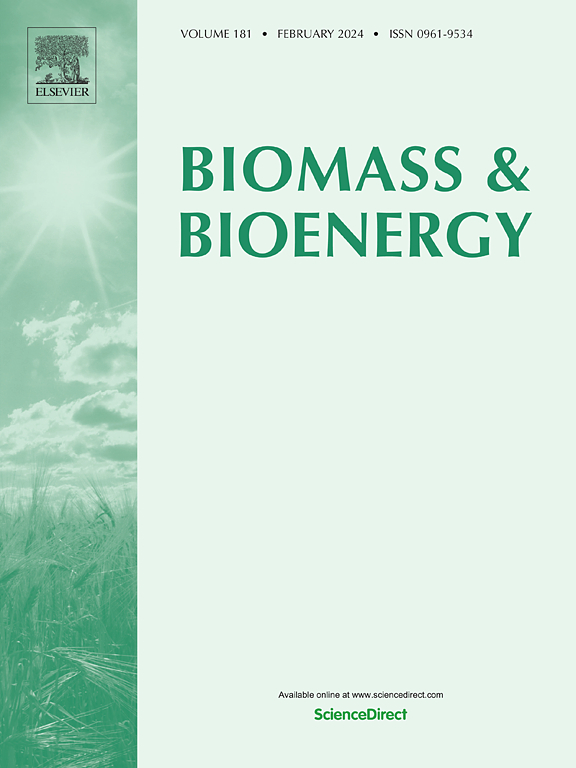壳聚糖复合绿色植物垃圾作为生物吸附剂对水中亚甲基蓝染料的有效去除:理化和吸附特性的研究
IF 5.8
2区 生物学
Q1 AGRICULTURAL ENGINEERING
引用次数: 0
摘要
本研究利用硫酸(H2SO4)对绿色蔬菜废弃物(生菜叶、甜菜茎和黄瓜皮)进行功能化处理,并与壳聚糖进行复合,制备了一种生物复合材料(现开始研究CHT/GVW-HS),可有效去除水中的亚甲基蓝(MB)染料。采用Box-Behnken设计(BBD)对CHT/GVW-HS用量(0.03 ~ 0.09 g)、去除时间(10 ~ 90min)、pH(4 ~ 10)进行了优化。BBD模型结果表明,达到最大MB去除率(98.57%)的理想值为pH约为10,CHT/GVW-HS剂量为0.065 g,接触时间为88 min。CHT/GVW-HS吸附MB的实验结果符合拟一阶模型和Freundlich模型。该生物材料对CHT/GVW-HS的吸附量高达296.83 mg/g,表明其吸附MB的能力较强。MB在CHT/GVW-HS上的吸附途径涉及静电、n-π、吉田h键和h键等多种相互作用。该研究促进了利用废弃生物质和生物聚合物生产可持续吸附剂,以有效地去除废水中的染料。目前的工作有助于实现若干可持续发展目标,如水下生命、清洁水和卫生设施、气候行动以及负责任的消费和生产。本文章由计算机程序翻译,如有差异,请以英文原文为准。

Green vegetable waste composited with chitosan as a bioadsorbent for effective removal of methylene blue dye from water: Insight into physicochemical and adsorption characteristics
In the current work, green vegetable waste (lettuce leaves, Swiss chard stems, and cucumber peel) was functionalized using sulfuric acid (H2SO4) and subsequently composited with chitosan to develop a biocomposite (starting now, CHT/GVW-HS) for effectively removing methylene blue (MB) dye from water. The adsorption variables, including CHT/GVW-HS dosage (0.03–0.09 g), removal time (10–90 min), and pH (4–10), were optimized using Box-Behnken Design (BBD). The BBD model's findings indicate that the ideal values for achieving maximum removal of MB (98.57 %) are a pH of approximately 10, a dose of CHT/GVW-HS of 0.065 g, and a contact duration of 88 min. The experimental results of MB adsorption by CHT/GVW-HS were in agreement with pseudo-first-order and the Freundlich models. The biomaterial exhibited a high adsorption capacity of 296.83 mg/g for CHT/GVW-HS, indicating its strong ability to adsorb MB. The adsorption route of MB on the CHT/GVW-HS involves various interactions like electrostatic, n-π, Yoshida H-bonding, and H-bonding. The study promotes the production of sustainable adsorbents using waste biomass and biopolymers to efficiently eliminate dyes from wastewater. The current work contributes to several Sustainable Development Goals (SDGs), such as Life Below Water, Clean Water and Sanitation, Climate Action, and Responsible Consumption and Production.
求助全文
通过发布文献求助,成功后即可免费获取论文全文。
去求助
来源期刊

Biomass & Bioenergy
工程技术-能源与燃料
CiteScore
11.50
自引率
3.30%
发文量
258
审稿时长
60 days
期刊介绍:
Biomass & Bioenergy is an international journal publishing original research papers and short communications, review articles and case studies on biological resources, chemical and biological processes, and biomass products for new renewable sources of energy and materials.
The scope of the journal extends to the environmental, management and economic aspects of biomass and bioenergy.
Key areas covered by the journal:
• Biomass: sources, energy crop production processes, genetic improvements, composition. Please note that research on these biomass subjects must be linked directly to bioenergy generation.
• Biological Residues: residues/rests from agricultural production, forestry and plantations (palm, sugar etc), processing industries, and municipal sources (MSW). Papers on the use of biomass residues through innovative processes/technological novelty and/or consideration of feedstock/system sustainability (or unsustainability) are welcomed. However waste treatment processes and pollution control or mitigation which are only tangentially related to bioenergy are not in the scope of the journal, as they are more suited to publications in the environmental arena. Papers that describe conventional waste streams (ie well described in existing literature) that do not empirically address ''new'' added value from the process are not suitable for submission to the journal.
• Bioenergy Processes: fermentations, thermochemical conversions, liquid and gaseous fuels, and petrochemical substitutes
• Bioenergy Utilization: direct combustion, gasification, electricity production, chemical processes, and by-product remediation
• Biomass and the Environment: carbon cycle, the net energy efficiency of bioenergy systems, assessment of sustainability, and biodiversity issues.
 求助内容:
求助内容: 应助结果提醒方式:
应助结果提醒方式:


